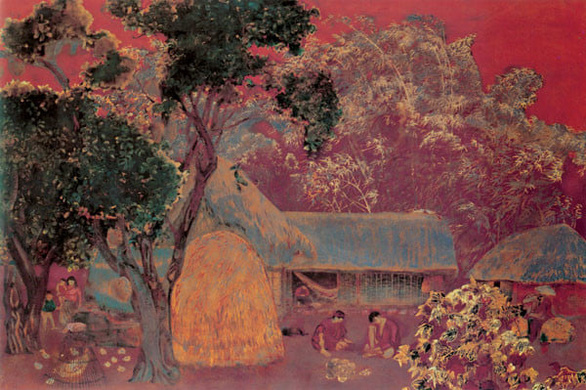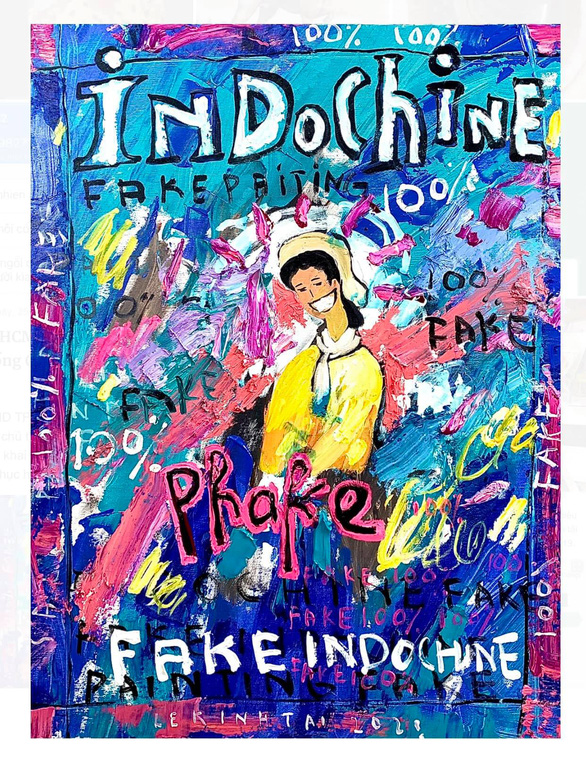On Tuesday, an announcement on the official website of Sotheby’s for its upcoming Modern Art Sale Day on October 10 still included general information on ‘L’image traditionnelle d’une maison de paysan’ by Ty.
The website did remove details regarding the piece’s expected auction price of HKD700,000-1,000,000 (US$89,000-128,500) and noted that “the lot has been withdrawn” from the upcoming auction.
“This work is comparable to ‘L’image traditionnelle d’une maison de paysan’ (‘Nha Tranh Goc Mit’ or rough translation, ‘Cottage By Jackfruit Tree’) (1958) by Nguyen Van Ty at the Musee des Beaux-Arts (Vietnam Fine Arts Museum) in Hanoi,” the site wrote.
Vietnamese art curator Ace Le had pointed out Sotheby’s strange use of the phrase ‘comparable to’ in its description of L’image traditionnelle d’une maison de paysan.’
He has also said that “nine out of ten veteran artists claim the brushwork on the [real piece and the alleged forgery] is totally different.”
On Tuesday, he announced that an associate of Sotheby’s addressed his concerns over the authenticity of the piece.
“Sotheby’s takes issues of authenticity seriously, and will withdraw this work from auction and conduct further investigations,” Sotheby’s stated in their announcement regarding the issue.
The removal of ‘L’image traditionnelle d’une maison de paysan’ from the auction was seen as a major victory for Ty’s daughter Nguyen Binh Minh, Ace Le, and a cohort of Vietnamese art lovers who raised concerns over the authenticity of the Sotheby’s lot.
Minh, who is also the former deputy director of the Vietnam National Fine Arts Museum (VNFAM), told Tuoi Tre (Youth) newspaper that his father made just one copy of ‘L’image traditionnelle d’une maison de paysan.’
That copy was displayed at Vietnam’s National Fine Arts Exhibition in 1958 and has been held in VNFAM’s collection since 1960.
In 2000, the piece won Ty a posthumous Ho Chi Minh Award for Literature and the Arts, a prestigious accolade presented by the Vietnamese government.
According to Minh, the alleged forgery fails to showcase her father’s flair and looks like “the work of an artistically uneducated person.”
She also said this is not the first time she has identified a forgery of her late father’s work.
Speaking with Tuoi Tre on Tuesday, Minh commended Sotheby’s willingness to take action.
She also expressed her hope that appraisal processes, specifically for works of late artists, are carried out diligently in order to avoid mistakes.
|
|
| ‘Nha Tranh Goc Mit’ by Nguyen Van Ty, as seen at the Vietnam Fine Arts Museum in Hanoi. Photo courtesy of the museum |
Epidemic of fakes
Reports of Sotheby’s including forgeries in its auction line-up were of no surprise to the Vietnamese art community, with many experts claiming the international market for Vietnamese paintings has been rife with fraud.
Though ‘Indochine arts,’ or artworks from the iconic graduates of the erstwhile Fine Arts College of Indochina, including To Ngoc Van, Mai Trung Thu, Nguyen Van Ty, and Nguyen Gia Tri, are crossing over the million-dollar mark on international auction floors, their reputation is being tarnished by the emergence of replicas that lead to widespread doubt across the market.
In late September, supporters of a countermovement against forged Vietnamese arts identified several imitations of famous works, including replicas of paintings by Bui Xuan Phai, Le Pho, and Mai Trung Thu slated for auction in France in October.
Art critic and researcher Nguyen Quan referred to these incidents as “the cliched everyday talks of auctioneers” due to their prevalence.
Meanwhile, artist Le Kinh Tai expressed his opinion on the issue through a satire piece entitled ‘Bia tap chi Tranh Dong Duong pha-ke’ (Fake Indochinese Art magazine cover), which depicts a caricature of a woman in ao dai — a theme frequently used by famous painters from the Fine Arts College of Indochina — as the cover girl of a ‘Fake Indochinese Painting’ magazine.
The painting “was born out of necessity, as fake Indochinese painting is too widespread,” Tai explained.
|
|
| ‘Bia tap chi Tranh Dong Duong pha-ke’ (Fake Indochinese Art magazine cover), a satire artwork by Le Kinh Tai |
Speaking on the upswing of fake Indochinese art, Ace Le pointed out that the phenomenon can be traced back to the late 1990s, when the genre first began gaining exposure at international auction houses.
However, the issue was only brought to local media’s attention recently.
According to Ace, it is time for Vietnam to mobilize public pressure, media coverage, and legal action to eradicate the prevalence of fake Indochinese paintings.
Since Vietnam only loosely regulates art sales, most auctions of Vietnamese art are subject to the laws of local governments, making it difficult for art collectors to file complaints regarding fraud.
As Ace sees it, the most effective way to clear fakes from the market is to protest and boycott forgeries.
Voices of opposition like Ace’s have made headway against the onslaught of counterfeits, as made evident by the removal of forged Indochinese paintings by Nguyen Gia Tri, Duong Bich Lien, and Bui Xuan Phai from an auction at French-based institute Tajan in July and the takedown of two other Indochinese works from Sotheby’s bidding list in September.
Like us on Facebook or follow us on Twitter to get the latest news about Vietnam!






